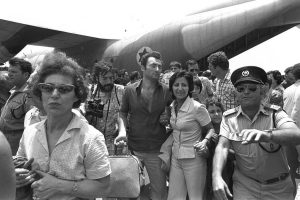
.
Terrorist outrages were as much a thing in the 1970s as they are today, but the protagonists and their causes were often different and their method, if crude, was in many respects more audacious and daring. To some extent this was down to the fact that surveillance methods were less well developed and thus it was easier for hijackers and suchlike to gain the initial advantage, exploiting the element of surprise. Nevertheless, there were times when nation states who were the victims of such attacks resolved to suppress them ruthlessly, often resulting in a grisly end for the perpetrators and their accomplices. Seldom has this been more demonstrably the case than in the events which culminated in the Raid on Entebbe, which coincidentally took place on the bicentenary of the ratification of America’s Declaration of Independence.
Hijack
The story began on June 27th when an Air France Airbus A300 (F-BVGG, for the plane spotters) carrying twelve crew members and 248 passengers on a flight from Tel Aviv to Paris was boarded by four hijackers during a stopover in Athens and diverted under duress via Benghazi in Libya to Entebbe in Uganda. The operation was a joint one by the Popular Front for the Liberation of Palestine (PFLP) and the German Revolutionary Cells, and was put into action with the intention of securing the release of 53 Palestinian and pro-Palestinian militants who were being held in various locations around the Western world, but principally in Israel.
Uganda in 1976 of course lived under the tyrannical rule of the despot Idi Amin or, to give him his full title, His Excellency, President for Life, Field Marshal Al Hadji Doctor Idi Amin Dada, VC, DSO, MC, King of Scotland, Lord of All the Beasts of the Earth and Fishes of the Seas and Conqueror of the British Empire in Africa in General and Uganda in Particular. Amin had earlier served with distinction in the British Colonial Army and had risen through the military ranks from being a lowly cook, through lieutenant and major, to becoming, post independence, Supreme Commander of the Ugandan Armed Forces. After having to come to power through a coup he had originally aligned himself with the Western powers, but had gradually drifted into the political orbit of Libya’s Colonel Gaddafi and also those of the Soviet Union and East Germany.
Unwitting Cargo
There are different and in some cases competing accounts of how Amin came to be afforded the dubious pleasure of hosting four hijackers, later to be joined by others, and their unwitting cargo of 260 prisoners. But to Entebbe they came, and a disused former airport terminal was made available to the hijackers for the purpose of housing their captives. Israeli and other Jewish passengers were then separated from non-Jews, and the latter were in due course released, leaving some 94 passengers under guard at Entebbe airport along with the 12 crew members who had refused to leave.
A deadline of July 1st was given, whereafter passengers would begin to be executed if the hijackers’ demands were not met. Meanwhile Israeli political and military leaders pondered the various alternatives available to them through which this awful situation might be resolved. Everything was considered, from negotiation to acceding to the terrorists’ demands to military intervention. No option was ruled immediately in or out, but the pros and cons considered carefully. Needless to say there were differences of opinion, and arguments aplenty. Eventually they persuaded Amin to use his influence to negotiate an extension of the deadline with the hijackers, which suited him as it enabled him to fulfil a prior engagement by flying to Mauritius to hand over the Chairmanship of the Organisation of African Unity (OAU). Crucially, this bought Israeli planners three extra days to perfect plans for a military operation.
No Diplomatic Solution
The subsequent release of formerly classified documents has shown that attempts to reach a diplomatic solution were made through the offices both of Anwar Sadat, then President of Egypt, and (through third parties) of the Palestine Liberation Organisation (PLO). Both came to nothing. Running in parallel to this was the mooting of a plan to drop Israeli naval commandos into Lake Victoria, which was quickly aborted due to the danger from crocodiles.
A full-scale airlift of hostages from Uganda across several jurisdictions between that country and Israel presented formidable logistical obstacles, but had increasingly begun to look like the only viable solution if the stalemate was to be broken and the lives of the captives spared. There appeared to be no reason to assume that the hijackers would not carry out their threat. The Lockheed C130 Hercules transport planes which were needed to fulfil the mission would have to be refuelled en route, and Israel lacked the capacity to perform this operation mid-air. Eventually, and after much initial resistance, Kenya was persuaded to allow them to use Jomo Kenyatta Airport for this vital function.
Intelligence on the location was gathered from some imaginative sources. The disused terminal had originally been built by an Israeli construction company, who were able to provide information on the layout. Unknown to the hijackers, one of the “non-Jews” they had released had in fact been an Israeli military officer with an unusual recollection for detail, who imparted his knowledge of the set-up within the terminal building with astonishing accuracy. Amongst other information he was able to impart related to which terrorists carried which weapons, and whereabouts on their persons. Other freed passengers volunteered further observations, enabling a really detailed picture to be constructed.
The Raid
On July 3rd the raiding party set off from Sharm el-Sheikh, on Sinai, now part of Egypt but then under Israeli occupation. Four Israeli Defense Force (IDF) Hercules transport aircraft containing around 100 troops and other personnel joined by two Boeing 707s offering logistical support flew low over the Red Sea to avoid detection from neighbouring Arab forces, who may have exposed the operation or even engaged the aircraft. After refuelling the first Hercules landed at Entebbe shortly before midnight. A black Mercedes limousine and a number of black Land Rovers raced towards the terminal building. The fleet was configured to imitate Amin’s presidential vehicle and its security detail, but one guard was aware that the dictator had recently traded his black Merc in for a white one and ordered it to stop. He and other sentries were shot but the Israeli assault team which was crammed into the various vehicles was forced to head for the terminal building at speed, fearing that its cover had been blown. As it happens the furore had gone unnoticed by the terrorists.
When they reached the terminal the assault team raced in and took the captors by surprise. A brief fire-fight ensued in which all the hijackers were killed. Sadly three hostages also lost their lives and a few were injured in the crossfire. Meanwhile the three remaining C130s had touched down at the airport.
Outside the building the remaining Israeli commandos set about destroying Ugandan fighter aircraft on the ground to prevent them from pursuing the Hercs once they were airborne. They were engaged by Ugandan soldiers and there was a battle in which 45 of the troops were killed, as well as one Israeli commander. The officer was Yonni Netanyahu, whose brother Benjamin would many years later become Prime Minister of Israel.
Rescued
When the C130s finally took off for Israel, they carried 102 rescued hostages bound for safety. Three had lost their lives during the battle. One more, an elderly lady by the name of Mrs. Dora Bloch, had been taken ill at the airport and driven to a local hospital before the arrival of the rescuing party. Reports suggest she was being well looked after prior to the raid, but in its wake she was tragically murdered upon an angry Amin’s insistence. A Ugandan doctor who objected was killed also.
Most commentators tend to the view that Operation Thunderbolt, notwithstanding the probably unlawful violation of another country’s sovereign territory (and the destruction on the ground of a quarter of its air force), saved a great number of lives. Four innocent civilians, a brave Ugandan doctor, an Israeli commander and seven hijackers were dead. And future hijackers were served notice that such actions could well lead to consequences quite different to those intended.
Many films were made shortly afterwards about the rescue mission, the most popular being Victory at Entebbe and Raid On Entebbe. Idi Amin continued his reign of terror in Uganda until being deposed in a coup in 1979 after an attempt to invade neighbouring Tanzania backfired spectacularly and ended with his own country being occupied by Tanzanian troops. He lived in exile in Saudi Arabia until his death from kidney failure in 2003.

If you enjoyed reading this article, make sure you stay updated with all Phil’s latest blog posts by signing up to receive his free Newsletter. You can unsubscribe at any time and your details will never be shared with any third party. Click here to sign up today.


